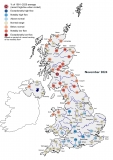Submitted by Steve Turner on
December was a cold month overall – the coldest December since 2010 for the UK as a whole – and drier than average for much of the UK. However, the cold, dry conditions prevailed through a sustained wintry episode in the first half of the month, whereas the latter weeks were mild, unsettled and wet, with rapid river flow recoveries, widespread flood warnings and locally high flows. Despite this runoff response, the December river flows were below average in many catchments and in some areas (northwest Scotland and East Anglia) flow deficiencies continued to grow. Similarly, while stocks increased in a majority of reservoirs, they remained 4% below average for England and 7% below average for Wales, and were particularly low in southwest England (Colliford was 43% below average, the lowest year-end stocks on record; Roadford was 27% below average, the third lowest) as well as some reservoirs in the Pennines, Wales and East Anglia. Groundwater recharge continued in many areas (notably the southern Chalk where levels were above normal) but had yet to start in more slowly responding boreholes where levels remained below normal. Consequently, despite a comparatively wet autumn/early winter, 2022 ended with many regions in England in drought status, a reflection of the longer-term rainfall deficiencies borne out by annual rainfall and flow statistics. The wet weather continued into early January and current Outlooks favour above normal river flows and groundwater levels. The New Year began with elevated flood risk for many areas, but rainfall over the coming weeks will also be important for dictating the water resources outlook for 2023 in those areas where deficits remain.



